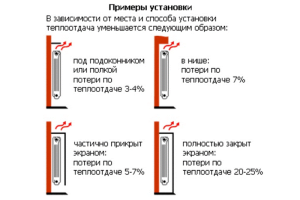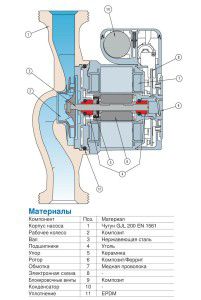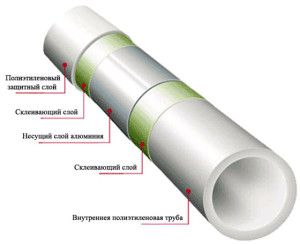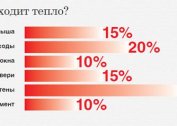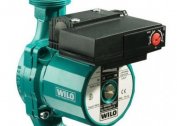How to choose all the components and elements of the heating system correctly? You need to use the main rule of professionals - pre-calculate the optimal parameters. Based on this, the actual technical characteristics of the heating systems are selected: radiators, pipes, pumps, boilers.
Why do you need to know the parameters of heating appliances
For a simple layman, the technical specifications of aluminum heating batteries, boilers and pumps are often just unnecessary information. But such an approach to the organization of heat supply can lead to disruption of its work and increase the likelihood of breakdown.
Knowing the necessary technical characteristics of gas heating boilers, you can correctly choose the optimal model. But for this, it is recommended that you first calculate the system parameters. The entire preliminary process for the preparation of a complete set of heat supply should consist of the following steps:
- Analysis of the condition of the house or apartment, determination of heat loss and the required temperature in each room. Do not forget that for outbuildings (garages, sheds, etc.) the technical characteristics of heating radiators can differ significantly from those for living rooms.
- Determining the optimal scheme - laying pipelines, the location of the boiler and batteries.
- Calculation of the required heating power for each room and the entire residential building (apartment) as a whole. Based on these data, the technical characteristics of electric heating boilers or their gas and solid fuel analogues are selected.
- Analysis of offers in the market. The priority at this stage is the quality and requirements that the technical characteristics of aluminum heating radiators and other heat supply devices comply with the calculated data.
This is a general scheme for organizing heat supply. Each of its items needs to be carefully studied and to identify all possible factors that may subsequently affect the performance of the entire system.
Some characteristics of steel heating radiators, boilers, pipes and pumps may differ from the declared ones. To avoid this, it is necessary to purchase products only of well-known and trusted manufacturers.
Characteristics of radiators and radiators
Which heating elements are the most important? First of all, these are radiators and batteries. It is these devices that are responsible for the quality transfer of thermal energy from hot water to the air in the room. Therefore, it is necessary to take into account all the technical characteristics of heating registers and their analogues.
Battery performance is a consequence of their technical data. So, the small weight of the radiator can talk about thin walls, which is not always acceptable. Especially for high pressure systems. Regardless of whether the calculation of the installation of heat supply is carried out independently or for this, specialists are involved - you need to know all the possible technical characteristics of cast-iron heating batteries, steel, aluminum and metal analogues.
For preliminary calculation of system parameters it is recommended to use professional software systems. Some of them are free, but a certain amount must be paid for using the rest.
Thermal efficiency, power
The decisive parameter for any heater is the thermal return from its surface. This is the main technical characteristic of heating radiators, measured in watts. Depending on the specific design, manufacturers indicate it either for one section or for the entire battery (panel).
In fact, heat transfer is the amount of energy that is transferred to the air in the room from hot water. For the calculation, the following parameters are taken into account:
- Thermal mode of heating. Manufacturers in the technical specifications of aluminum heating batteries often indicate power for 85/60 mode. However, in low-temperature operation, the nominal heat transfer of the batteries will be lower;
- Overall dimensions. There is a direct relationship between the power of the radiator and its surface area. When taking into account the technical characteristics of aluminum heating radiators, it is necessary to take into account not only their height and width, but also their depth;
- The volume of coolant placed in the radiator. The more it is, the higher the thermal return. But at the same time, there is a quick cooling of hot water, which should enter the subsequent heating devices along the mains.
Power is the most important technical characteristic of heating radiators. It must be indicated in the technical passport for a specific model for several thermal modes of heat supply.
To increase the nominal heat transfer, you can install a reflective screen on the wall, as well as repaint the battery in black. This will reduce heat loss.
Dimensions and center distances
The dimensions of the batteries are necessary not only for a preliminary calculation of power, but also serve as the basis for choosing the installation location of heating components. This technical characteristic of the heating registers is also necessary for the correct connection.
Consider the main dimensional data of heat supply batteries:
- Height. It is considered from the lower to the upper plane of the device;
- Width. For sectional models is the sum of the width of each element. Be sure to take into account the dimensions of the connecting pipes between the sections;
- Depth;
- Center distance. This is the distance between the upper and lower channels for the coolant. Depending on the required technical characteristics of the cast-iron radiators, the distance can be from 200 to 900 mm. This directly affects the overall height of the structure.
For proper installation of the radiator, it is necessary to consider the minimum distances from its planes to the floor of the walls and window sill. If you install the structure back to back, the technical parameters of the aluminum heating batteries will deteriorate significantly.
In addition to this, you need to know the dimensions of the fasteners. After installing the battery, it must be firmly fixed. If you perform the installation incorrectly, there will be extraneous noise from vibration and the risk of structural breakage will increase.
The overall technical characteristics of aluminum heating radiators directly affect their weight. This is especially true for cast iron structures, which have the largest weight among all heat supply devices.
Nominal pressure and water temperature
During operation of a closed heating system, water expands due to its heating. This causes high pressure in the pipes. Therefore, the technical characteristics of heating radiators must be no less than the critical pressure value in the system.
It should be borne in mind that in spite of the good performance characteristics of steel heat supply radiators, the probability of the appearance of excessive short-term pressure is always possible. This phenomenon is called water hammer. Typically, the pressure value is then 2-3 times higher than the critical value.For the right choice, you need to know the values of the system parameters and recommendations for the selection of certain radiator models.
| Radiator type | Pressure value, bar | Recommendations for choosing heating | |
| Optimal | Critical | ||
| Aluminum | 10 | 20 | Standalone |
| Bimetallic | 15 | 30 | Centralized and autonomous |
| Steel panel | 8 | 15 | Standalone |
| Cast iron | 12 | 35 | Centralized and autonomous |
When analyzing the technical characteristics of the heating registers for closed heat supply with forced circulation, the pressure of the pressure must be taken into account. It exceeds the optimum by 1.25 times.
An additional characteristic of electric radiators is the power consumption.
Overview of boiler characteristics
A boiler is needed to heat water in an autonomous heating system. Depending on the type of energy used, you can choose models that run on solid fuel, diesel, gas (natural or balloon).
But in addition to this parameter, other, equally important technical characteristics of gas heating boilers must be taken into account. They must be indicated by the manufacturer in the technical passport. In the absence of this document, it is recommended to find a description of a similar model on the Internet:
- Power. Determines the amount of thermal energy generated to increase the temperature of water. Measured in watts;
- Number of circuits. To a greater extent, this applies to the technical characteristics of gas heating boilers, which in addition to heating the premises provide hot water supply. The main indicators of the second circuit is the rate of heating water to the desired level for a certain period of time - l / h;
- Efficiency - the ratio of the power consumed by the energy carrier to the generated thermal energy. A good indicator is a value from 90% to 95%. For solid fuel and diesel models, the efficiency rarely exceeds 85%. The highest characteristics are observed in electric heating boilers.
All other functions, which include adjusting the degree of water heating, monitoring the operation of the device, remote control, are operational. They are typical for certain boiler models. However, in most cases, they do not affect the above technical parameters.
The parameters of all components of the boiler must be taken into account. So, many gas and electric models are equipped with a circulation pump, an expansion tank and a safety group.
Parameters of circulation pumps for heating
To increase the velocity of the coolant through the pipes, it is necessary to install pumps in the heating system. With their help, you can change not only the thermal distribution of the radiators, but also stabilize the thermal mode of operation. All the technical characteristics of the heating pumps describe the parameters that affect these indicators.
Almost all models have standard overall dimensions. The only exceptions are paired, in which the characteristics of the circulation pumps for heating systems are significantly higher than the others. To analyze their parameters, you need to know the following values:
- Nominal value of an expense - l / hour. Determines the amount of water that is pumped through the device in 1 hour. The higher this value, the greater the flow rate of the coolant in the system;
- Pressure. It characterizes the maximum hydraulic resistance that the pump can overcome. Measured in meters;
- Hydraulic losses. It is displayed in the form of a graph and indicates the value of the pressure loss depending on the water pressure flowing through it;
- Electric current consumption, W. This is not the most important technical characteristic of pumps for heating, since rarely its value exceeds 300 W / h.
In addition to these characteristics of circulation pumps for heating, you need to know the diameter of the connected pipes, the rules for installing equipment in the system. These parameters should correspond to the calculated ones.
In the technical specifications for heating circulation pumps, the critical values of the voltage drop are indicated. If it is more than the actual one, it is necessary to install an additional voltage stabilizer.
How to choose pipes - characteristics of highways
To create a closed heating circuit, the installation of transport lines is necessary. Recently, polymer products have been used for this. It should be borne in mind that the technical characteristics of polyethylene pipes for heating are very different from steel analogues.
To complete the autonomous heating system, it is necessary to use special models of plastic pipes. In their design there is an additional reinforcing layer that prevents deformation under the influence of hot water. It directly affects the technical characteristics of polypropylene pipes for heating:
- Maximum hot water heating. In the characteristics of polyethylene pipes this value does not exceed + 85 ° C. Short-term temperature exposure up to + 90 ° С is possible;
- System pressure. It can be up to 10 atm. If this parameter is higher, it is recommended to choose PN25 brand designs for which the technical characteristics of the maximum pressure of polypropylene pipes for heating are at around 25 atm;
- Diameter - inner and outer. The wall thickness of the structure is also taken into account.
As with the other components of the heat supply, the technical parameters of polyethylene pipes for heating should be equal to the calculated ones. Even a small error can lead to an increase in the risk of rupture or loss of thermal energy during the passage of the coolant.
The video shows an example of choosing a heating boiler:




